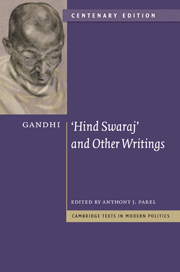Book contents
- Frontmatter
- Contents
- Preface to the centenary edition
- Acknowledgements
- Editor's introduction to the centenary edition
- Editor's introduction to the 1997 edition
- A note on the history of the text
- Principal events in Gandhi's life
- Biographical synopses
- Guide to further reading
- Glossary and abbreviations
- HIND SWARAJ
- SUPPLEMENTARY WRITINGS
- Gandhi's letter to H. S. L. Polak
- Gandhi's letter to Lord Ampthill
- Preface to Gandhi's edition of the English translation of Leo Tolstoy's Letter to a Hindoo
- Gandhi–Tolstoy letters
- Gandhi and the ‘Four Canonical Aims’ of Life (Purusharthas)
- Gandhi–Nehru dialogue
- Economic development and moral development (1916)
- Gandhi on machinery (1919–47)
- Constructive programme: its meaning and place (1941, rev. 1945)
- Gandhi's political vision: the Pyramid vs the Oceanic Circle (1946)
- Draft Constitution of Congress (1948)
- Bibliography
- Index
Gandhi's political vision: the Pyramid vs the Oceanic Circle (1946)
Published online by Cambridge University Press: 05 October 2014
- Frontmatter
- Contents
- Preface to the centenary edition
- Acknowledgements
- Editor's introduction to the centenary edition
- Editor's introduction to the 1997 edition
- A note on the history of the text
- Principal events in Gandhi's life
- Biographical synopses
- Guide to further reading
- Glossary and abbreviations
- HIND SWARAJ
- SUPPLEMENTARY WRITINGS
- Gandhi's letter to H. S. L. Polak
- Gandhi's letter to Lord Ampthill
- Preface to Gandhi's edition of the English translation of Leo Tolstoy's Letter to a Hindoo
- Gandhi–Tolstoy letters
- Gandhi and the ‘Four Canonical Aims’ of Life (Purusharthas)
- Gandhi–Nehru dialogue
- Economic development and moral development (1916)
- Gandhi on machinery (1919–47)
- Constructive programme: its meaning and place (1941, rev. 1945)
- Gandhi's political vision: the Pyramid vs the Oceanic Circle (1946)
- Draft Constitution of Congress (1948)
- Bibliography
- Index
Summary
Gandhi's vision of the relationship between the individual, the state and the world community is articulated in an interview he granted on 28 July 1946. [Ed.]
Question: You have said in your article in the Harijan of July 15, under the caption ‘The Real Danger’ that Congressmen in general certainly do not know the kind of independence they want. Would you kindly give them a broad but comprehensive picture of the Independent India of your own conception?
Answer: I do not know that I have not, from time to time, given my idea of Indian independence. Since, however, this question is part of a series, it is better to answer it even at the risk of repetition.
Independence of India should mean independence of the whole of India, including what is called India of the States and the other foreign powers, French and Portuguese, who are there, I presume, by British sufferance. Independence must mean that of the people of India, not of those who are today ruling over them. The rulers should depend on the will of those who are under their heels. Thus, they have to be servants of the people, ready to do their will.
Independence must begin at the bottom. Thus, every village will be a republic or panchayat having full powers. It follows, therefore, that every village has to be self-sustained and capable of managing its affairs even to the extent of defending itself against the whole world.
- Type
- Chapter
- Information
- Gandhi: 'Hind Swaraj' and Other Writings , pp. 181 - 183Publisher: Cambridge University PressPrint publication year: 2009



